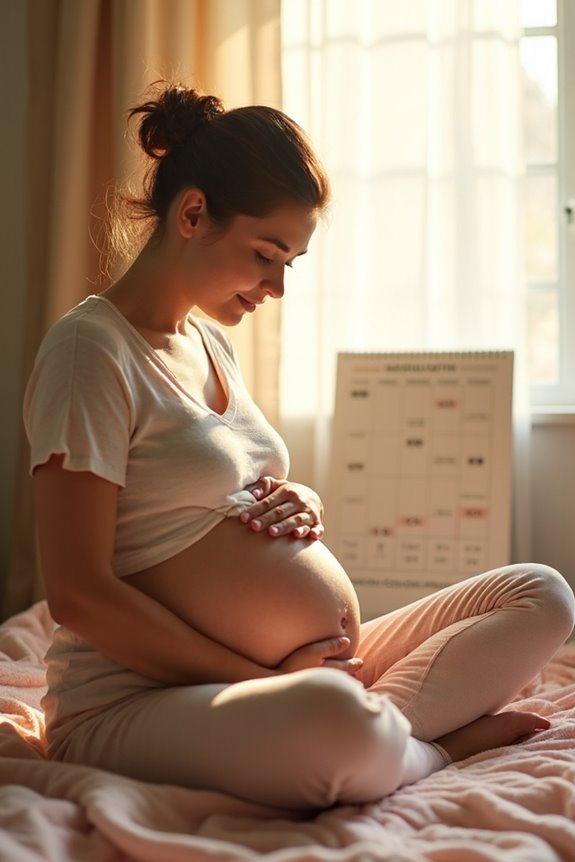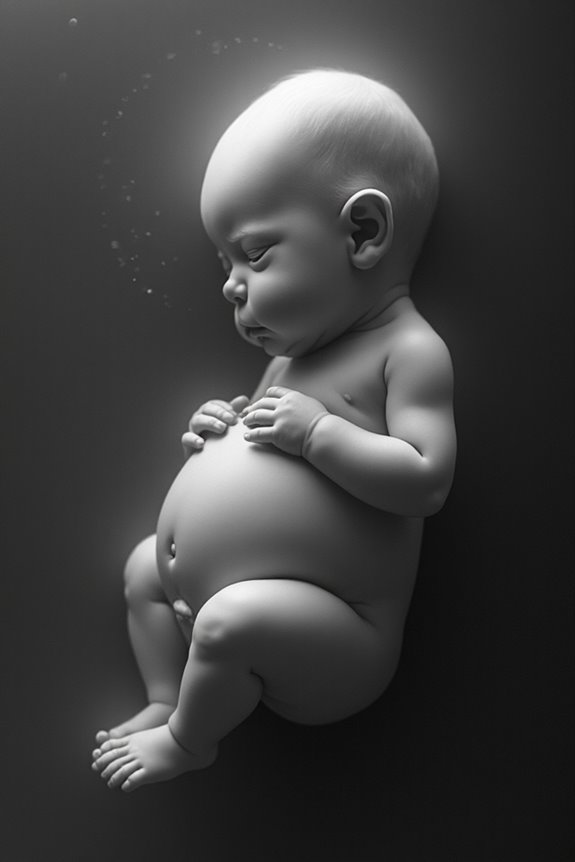During pregnancy, we usually start feeling our baby move between 16 to 20 weeks. Those first gentle flutters, known as quickening, are exciting signs of life. If you’re experienced, you might notice them as early as 16 weeks. As the weeks pass, movements become more pronounced and frequent, especially in the afternoon and evening. It’s important to monitor these movements, as they indicate your baby’s health. Let’s explore how movements change and tips for keeping track of them.
Key Takeaways
- Fetal movement is typically first felt around 20 weeks, or as early as 16 weeks for experienced mothers.
- Movements are often subtle at 16 weeks, becoming more noticeable at 20 weeks, known as quickening.
- By 24 weeks, fetal movements become more pronounced and energetic, increasing in frequency and strength.
- After 28 weeks, aim to feel at least 10 movements within two hours to ensure baby’s health.
- Changes in movement patterns or significant decreases warrant contacting a healthcare provider for advice.
Understanding Fetal Movement Timing
Understanding fetal movement timing is essential for expectant parents, as it offers insight into their baby’s development and well-being. Typically, we begin to feel fetal movement around 20 weeks, though if you’ve been pregnant before, it could start as early as 16 weeks.
- The baby’s size and strength often mean that we, as mothers, are the first to notice these movements.
- Fetal activity peaks in the afternoon and evening, creating a lovely connection during quieter moments.
- Generally, movements increase until about 32 weeks, after which they plateau.
Recognizing these pregnancy symptoms helps us tune into our baby’s patterns, allowing us to monitor their health and growth effectively, ensuring a more intimate bond as we await their arrival.
Factors Affecting Early Detection

While many factors influence when we first feel our baby move, it’s important to remember that each pregnancy is unique. Several aspects can affect our sensitivity to those delightful movements.
- Maternal Experience: If we’ve been pregnant before, we might recognize movements sooner.
- Fetal Development: Typically, we begin to feel movements between 16 to 20 weeks as the fetus grows.
- Hormonal Influences: Changing hormones can impact how we perceive movements.
- Lifestyle Modifications: Regular exercise and a balanced diet may enhance our sensitivity.
- Environmental Factors: Stressors in our surroundings can also influence our awareness of movements.
- Medical Conditions: Pre-existing health issues or pregnancy complications might alter our sensitivity.
Describing Early Fetal Movements

Feeling your baby move for the first time is a memorable experience that many expectant parents eagerly await. Those early fetal movements often arrive between 16 to 25 weeks and can feel like gentle fluttering sensations or even nervous twitches. We might compare these delicate movements to bubbles or light tapping, making them easy to miss if we’re not paying close attention.
For first-time parents, recognizing these subtle signals may take a bit longer, usually around 20 weeks. However, second-time parents might notice them as early as 13 weeks. To truly connect with these early moments, it’s important to be still and attentive, allowing ourselves to embrace the magic of those first tiny movements inside.
Changes in Movement Through Pregnancy

As we progress through pregnancy, the way we experience our baby’s movements can change significantly.
- Week 16: We might feel subtle movements, but they’re often too gentle to notice.
- Week 20: That’s when many of us start feeling those first noticeable kicks, known as quickening.
- Week 24: Movements become more pronounced, and we can feel the baby’s energy.
- Week 28: Expect more frequent and stronger kicks and jabs, marking a lively phase.
- Weeks 36-40: As space becomes tight, the movements may shift to more rolling and twitching instead of vigorous kicks.
Understanding these changes helps us connect with our baby, making each phase of movement a special part of our journey together.
Fetal Activity Patterns and Sleep

Understanding fetal activity patterns and sleep can help us feel more connected to our baby during pregnancy. Fetal activity varies throughout the day, typically peaking in the afternoon and evening due to diurnal variations. You might notice increased movement after meals, as fetal activity often spikes within 15 minutes of eating.
Fetuses experience regular sleep cycles lasting 20-40 minutes, during which we may perceive less movement. As gestational age increases, these movement patterns can become more pronounced, reflecting neurological development. Environmental influences, like your voice, can also stimulate activity. It’s essential to stay attuned to these patterns; recognizing normal fluctuations can ease concerns about fetal well-being and enhance our bond with our growing baby.
The Role of Maternal Sensitivity

Recognizing fetal movements can be an exciting part of our pregnancy journey, and maternal sensitivity plays a crucial role in this experience. Our maternal awareness enhances our ability to perceive these movements, especially when we’re still and attentive. Here are some key points to consider:
- Gestational Age: We typically start feeling movements between 15 and 20 weeks.
- Movement Types: Synchronous movements of the trunk and limbs are easier to notice.
- Variability: Our sensitivity varies, meaning some of us may detect movements better than others.
Monitoring Your Baby’s Movements

Monitoring your baby’s movements is an essential part of ensuring their well-being during pregnancy. By keeping track of fetal movements, we can engage in a vital movement assessment that helps us understand our baby’s health. Here are some effective monitoring techniques:
- Fetal Movement Counts: Regularly count your baby’s movements, as this can predict potential issues.
- Nonstress Test (NST): This test measures the heart rate in response to movements.
- Biophysical Profile (BPP): Combining ultrasound and NST, this method assesses overall well-being.
Using tools like handheld Dopplers and fetal monitors can enhance our fetal monitoring experience. Remember, consistently monitoring movements could lead to early detection of urgent delivery needs, ultimately improving outcomes for our little ones.
Importance of Fetal Movement

Fetal movement plays a significant role in gauging our baby’s health and development during pregnancy. These movements are crucial indicators of fetal health, giving us reassurance that our little one is active and growing.
- Movement significance: Regular activity helps develop joints and the spine, essential for healthy growth.
- Decreased movement: If we notice less activity, it can signal potential health issues, so staying aware is important.
- Patterns change: As pregnancy progresses, we’ll notice variations in movement, which reflect our baby’s development.
Tracking these movements not only enhances our connection to our baby but can also ease anxieties about their well-being. By paying attention to our baby’s movements, we actively participate in ensuring their health and growth during this special time.
When to Seek Medical Advice

It’s essential to pay attention to any changes in your baby’s movements during pregnancy, especially as we approach the later stages. If we notice a decrease in movement or a sudden increase, it’s time to seek medical advice. Trusting our maternal instincts is crucial for fetal health.
Here are some key points to consider:
- Change in Patterns: If you feel a noticeable change in your baby’s movements, reach out to your healthcare provider.
- Monitoring Movements: After 28 weeks, aim for at least 10 movements within two hours.
- Emergency Situations: Don’t hesitate to visit the hospital if you have concerns.
Strengthening the Maternal Connection

As we focus on the importance of recognizing changes in our baby’s movements, let’s also consider how these experiences can help us strengthen our bond with our little one. Feeling those first flutters can be a magical moment, enhancing our emotional connection. Here’s how we can nurture that maternal bonding:
- Stay Mindful: Practicing mindfulness can reduce stress, allowing us to connect better with our baby.
- Reflect on Past Experiences: Understanding our pregnancy history helps us process emotions, which can improve bonding.
- Engage in Supportive Activities: Joining parenting groups or seeking support can enhance our connection and reduce feelings of isolation.
Frequently Asked Questions
Can Fetal Movements Indicate the Baby’s Gender?
Imagine a gentle breeze whispering secrets of our baby’s journey. Yet, those fetal kicks don’t reveal gender prediction to us. Instead, let’s cherish each movement as a sign of life and connection.
Do Certain Foods Affect Fetal Movement Intensity?
We’ve all wondered if spicy foods or sugary snacks might get our little ones moving more. But studies show they don’t actually affect movement intensity; it’s more about our focus and awareness during that special time.
Can Stress Impact Fetal Movement Patterns?
We know stress effects can significantly shape fetal reactions. When we feel anxious or overwhelmed, our baby might respond differently, altering movement patterns. It’s essential to care for our mental well-being during this special journey.
Is It Normal to Feel Less Movement Some Days?
It’s completely normal to feel less movement some days; about 70% of reduced movements result in healthy pregnancies. Our baby’s movement patterns can vary, reflecting their development, so let’s stay connected and trust our instincts.
How Does Maternal Position Affect Fetal Movements?
We’ve learned that our maternal posture significantly affects fetal activity. When we relax in a recumbent or left lateral position, we often feel those precious movements more clearly, creating a deeper connection with our little one.





